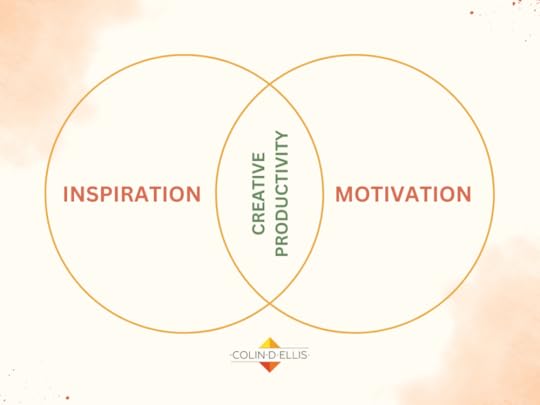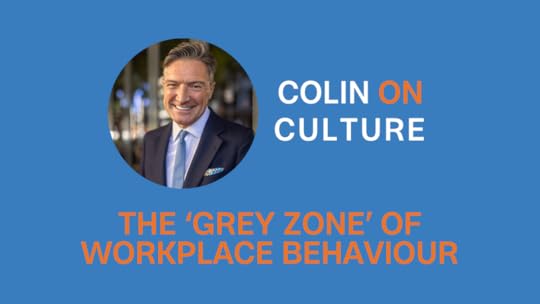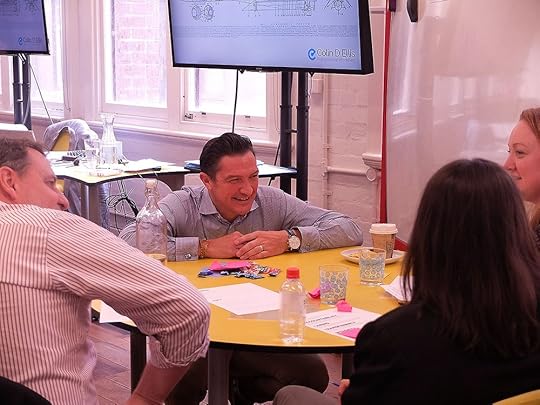Colin D. Ellis's Blog, page 13
May 19, 2025
Why inspiration needs motivation
A couple of weeks ago I was asked whether I was an inspirational or motivational speaker. The person asking had had a couple of drinks and I’m sure the question was tongue in cheek (or as we say in England ‘taking the Mick’), but I replied honestly, anyway, ‘Both, because, being just one of those things will leave an audience disappointed.
If you were to draw a Venn diagram that represents human achievement, it would look something like this:

While often used interchangeably, inspiration and motivation are different yet complementary forces in our journey toward accomplishment. It may seem like I’m splitting hairs, but it’s true.
Inspiration is a flash of brilliance, an elegant solution, or a vision of what could be. It's a spark that ignites possibility in our minds. Sometimes it offers a glimpse of a creative path we hadn't considered, other times it’s an energy we feel or ‘take’ from others. Inspiration can strike at any moment: during a morning shower, on a countryside walk, reading a book, listening to music, watching a speech or Ted Talk or just amidst the hum of urban life.
Yet inspiration alone remains merely potential energy. Without its crucial partner, motivation, even the most brilliant ideas will go unrealised.
Motivation transforms inspiration from concept to tangible reality. It's the disciplined force that propels us through challenges, fuels late-night flow state work sessions, and sustains momentum when initial excitement fades. It’s the practical reality that inspiration can’t always see, a lit pathway to making a dream a reality.
The magic happens at the intersection where these forces overlap. When inspiration ignites our imagination and motivation drives us to action, we enter the sweet spot of creative productivity. This partnership explains why some brilliant minds never translate their genius into meaningful output, while others with perhaps less innate creativity produce remarkable work consistently.
Understanding this relationship offers a practical framework for achievement: cultivate environments that welcome inspiration, but build systems that generate motivation. Seek moments of creative insight, then immediately look to establish structures to transform those insights into action.
The most successful innovators master not just the art of capturing inspiration, but the science of sustained motivation. The same is true of public speakers too. Yes it’s important to feel inspired, but without the practical knowledge to motivate you to do something different, you’re only getting half the picture.
Subscribe to Colin on Culture Sign up with your email * indicates required Email Address *May 18, 2025
Productively stopping
In vibrant workplace cultures, productivity isn't about being constantly busy, it's about taking strategic pauses. The most effective teams recognise that they are at their best when periods of intense focus are followed by deliberate disengagement.
When leaders model boundary-setting by ending meetings punctually and respecting offline time, they generate psychological safety and self-care. Employees who know when to stop experience less burnout, make fewer critical errors, and contribute more meaningfully during collaborative sessions.
It’s a paradox of productive cultures: knowing when to halt is precisely what propels you forward.
Subscribe to Colin on Culture Sign up with your email * indicates required Email Address *May 15, 2025
10 things I would tell my 17-year old self
The world of work is very different from when I started 38 years ago. I’ve never been one for regret, but I think we all like the idea of being able to inform our younger selves about what the future holds, in order to provide some much needed insight of how we should evolve.

Me in 1987
This isn’t a Back to the Future take, where I invest in Microsoft, make millions and retire wealthy yet (probably) unhappy at a life unfulfilled! It’s more about my own personal evolution, what I’ve learned and hopefully there’s something in here for others too.
So here are the 10 things I would tell my 17-year old self (and yes, that really is a picture of me aged 17!):
Be a good human - we are all just humans trying to do a good job. Ignore or challenge (where appropriate) those that seek to de-humanise work
Relationships are key - work hard to build relationships and have empathy for those who aren’t like you. Don’t judge, ever and try not to gossip, it’s a horrible thing to do
Mental health is as important as physical health - keep up the football and the gym, but make some time for quiet reflection and enjoy the small moments
Keep laughing - it has many health benefits, and being able to find moments of laughter through the stress of work will benefit others too
Look for organisations that treat their people well - it’s not all about pay, happiness is driven by how those at the top treat those, like you, at the bottom
Technology will change everything - be curious about what’s possible, learn how to use it properly and steer clear of the cynics who seek to maintain the status quo
Choose difference over deference - it’ll be tempting to just follow the herd when it comes to how work gets done, copy the good but also look for ways you can do things differently
Attitudes will constantly change - what’s considered to be ‘normal’ about the way that we work shifts constantly, be open not resistant to change
Be inspired by small acts - inspiration can be found everywhere, use it as fuel to be a better person or to get better at what you do
Be disciplined - it’s easy to give up and ‘settle’ for something. Time is the most precious commodity that you have and it goes by faster than you can imagine. So be disciplined and make the most of the time that you have
Be prepared for disappointment - Everton are brilliant at the minute but trust me, that won’t last and it will be a constant source of frustration and disappointment. It’ll build your life resilience though…
OK, so it did turn into Back to the Future with point number 11! What would you tell your 17-year old self about the world of work?
Subscribe to Colin on Culture Sign up with your email * indicates required Email Address *May 14, 2025
Thriving in chaos
The term ‘thriving in chaos’ seems like an oxymoron. How can you thrive when the world around you is chaotic?
Yet, chaos doesn’t necessarily have to be a bad thing, providing you're brave enough to embrace it! The most vibrant cultures that I’ve worked with aren't avoiding disruption, instead they see it as energy to power future opportunity.
Netflix deliberately releases 'chaos monkeys' into their systems to strengthen resilience, while Morning Star's seemingly chaotic self-management consistently outperforms traditional hierarchies.
For most organisations this requires a fundamental mindset shift, where we stop treating unpredictability as something to control and start seeing it as the fertile soil from which creativity and innovation can sprout.
The secret ingredient is a workplace culture built on psychological safety, where team members feel empowered to experiment boldly without fear of punishment.
Remember, the most successful leaders today aren't those with the most detailed plans but those who establish clear boundaries within which creative disorder can flourish. Chaos isn’t going anywhere, so instead, look to build the cultural capabilities to turn turbulence into your greatest competitive advantage.
Subscribe to Colin on Culture Sign up with your email * indicates required Email Address *May 13, 2025
A fool with a tool
The phrase ‘a fool with a tool’ refers to the principle that simply giving someone advanced technology or tools doesn't automatically improve their performance or outcomes if they lack the underlying knowledge, judgment, or skills to use those tools effectively.
It highlights, therefore, that tools are only as valuable as the skills of the person using them. Even the most ‘user-friendly’ technology tool cannot compensate for fundamental gaps in understanding, critical thinking, or expertise.
The implications of this are as follows:
Technology amplifies capability: Tools don't create capability where none exists, they magnify existing capabilities, both positive or negative. Adding a new Teams channel to ‘make things easier’ won’t be effective if people don’t know how to use Teams Channels properly in the first place!
Skills and behaviours before tools: Organisations often make the mistake of investing heavily in new systems or technologies without adequately preparing their people to use them effectively. This is a key reason why so many digital transformations fail. Organisations implement the digital tool before transforming the culture
Misplaced confidence: Possessing advanced tools can create a false sense of competence in individuals who lack foundational knowledge. Microsoft Excel is a great example of this. Almost every office worker will say on their resume that they can confidently use Microsoft Excel, yet very few have the competence to use it effectively
Systemic consequences: In organisational settings, this can lead to wasted resources, failed initiatives, and potentially harmful outcomes when decisions are made using poorly understood tools. AI is the latest example of this. Having access to ChatGPT is one thing, knowing the right questions to ask or how to spot the flaws in responses is something else altogether and that could lead to embarrassment
In order to ensure that technology complements and enhances the culture, organisations should always prioritise the following when implementing new technologies or methodologies:
- Reset the culture and behaviours required to adopt the new tool
- Build foundational competence before tool adoption
- Create learning cultures that emphasise continual tool mastery over mere tool acquisition
- Develop emotional intelligence alongside technical capabilities
- Establish feedback mechanisms to identify when tools are being misused or badly employed
By following these steps can avoid the trap that most fall into by creating fools with expensive tools that they will never see a return on.
Subscribe to Colin on Culture Sign up with your email * indicates required Email Address *May 12, 2025
4 Basic Steps to a Data Security Culture
Data breaches pose a significant threat to organisations today, with cyberattacks having increased notably in recent years.
While technical solutions are vital, many data breaches are caused by careless individuals within the organisation. Either through not carrying out basic tasks to keep data secure or not following through on the actions required to prevent bad actors from accessing systems.
This underscores a key point from my book Culture Fix: people's behaviour will ultimately define how safe your information is. Making data security a priority within the strategy from the outset ensures necessary investment, but fostering a culture where security is embedded in daily actions is paramount.
The compromise of the Indian government's Aadhaar system exposing data for nearly a billion people demonstrated how vulnerable vast datasets can be, let alone the recent breaches at Marks & Spencer, the Co-op and Harrods. Cybercriminals are constantly looking for ways to gain access.
Building a multi-layered defence requires awareness and collaboration across the culture. However, here are four basic things everyone within the culture can do to contribute to data safety:
Create strong, unique passwords that are hard to figure out, and crucially, do not write them down near your computer
Be vigilant; look out for anything that seems electronically suspicious (this includes the IT Helpdesk!). Do not open emails with dodgy titles or from unknown senders, and never open their attachments
Ensure all software is kept updated to ensure the latest security updates and features are being applied
If working remotely, know how to secure data when out of the office. Avoid taking sensitive information out on portable devices and always be mindful of who’s around you
Beyond these individual actions, organisations should avoid generic user accounts, regularly check user credentials (what people are allowed access to), and close user accounts promptly when people leave.
Ultimately, securing data isn't just about firewalls and policies; it requires a collective commitment and discipline. By embedding security-conscious behaviours into the cultural fabric (the 'way we do things around here') organisations can significantly enhance their defence against threats and ensure that they don’t expose their customers' data or their data security ineptitude to the outside world.
Subscribe to Colin on Culture Sign up with your email * indicates required Email Address *May 11, 2025
The 'grey zone' of workplace behaviour
The recent culture review into the BBC highlighted many issues, not least what is considered to be acceptable behaviour in the workplace.
In this episode I explore the reports findings and talk through the actions thar organisations can take to ensure that ‘grey zone’ behaviour doesn’t generate toxicity.
Click the link below to watch the video or search Colin on Culture wherever you get your podcasts.
 Subscribe to Colin on Culture Sign up with your email * indicates required Email Address *
Subscribe to Colin on Culture Sign up with your email * indicates required Email Address *
May 8, 2025
Trusting your gut
As a senior leader in the private and public sector I was programmed to analyse, research and plan. To dot every ‘i’ and cross every ‘t’. To check, double check and in some cases, triple check! These are valuable tools and ways of thinking and yet sometimes, your subconscious processes information in ways your conscious mind can’t really articulate.
In those moments instinct isn’t irrational, it’s your experience and expertise communicating through feeling rather than thought.
It’s not about blind leaps of faith, but occasionally when that persistent feeling won’t subside perhaps it’s worth asking yourself, ‘What might happen if I trust my gut?’
The head and gut are often in constant argument with each other. When you wake up you ‘feel’ that now is the time to do something, then the head takes over and the gut takes a back seat until you next have the chance to ‘listen’ to it again.
It could be a decision in work about a relationship you’d like to build, a way of presenting information or of doing things differently. It could be your instincts about an individual in a role or it could be a feeling about your own development and future career path.
If the gut feeling is strong, then sometimes, logic needs to be placed to one side.

An early workshop!
I had no plans to ever work for myself, and yet 10 years ago I found myself at such a crossroads. We had a young family, no money and had not long arrived in a new country.
Yet I knew three things to be true in my working life:
I was tired of undertaking bland ineffective development programmes
I was bored of uninspiring leadership offsites with crammed agendas; and
I was frustrated working with managers who lacked the basic skills to get the job done
Not that I thought I was the perfect leader, far from it, however I was good at facilitation and had developed a formula for building high-performance teams, one that consistently produced results when traditional approaches failed.
Each morning, I'd arrive at my comfortable corporate job and feel that same feeling: “I think there’s a better way and I want to share it with other companies.”
Starting my own practice terrified me. There was no five-year plan, just a determination to get started before my head took over! Where would I find clients? How would I manage the administrative side? Could my approach scale?
But instinct doesn't provide detailed roadmaps, money or a perfect date on which to start, it simply points in a direction and says, "Trust me."
So I did.
Today, my client list spans industries and countries I never imagined entering. My books have helped individuals and teams in places I’ve never heard of! My team-building formula has evolved through application in diverse environments. Most importantly, I've witnessed transformations that validate what my instincts knew all along.
Yet, had I based my decision on my head alone I wouldn’t be in this position now. Sometimes you just have to trust your gut, then work hard to prove it was right!
Subscribe to Colin on Culture Sign up with your email * indicates required Email Address *May 7, 2025
Doing something different
Alan Draper was one of the co-founders of Virgin Records. When he was asked in an interview why the company was so successful he said, ‘We were a team of people all motivated by a common goal, to do something different.’
When leaders make the results the target, there’s a good chance they will miss it. Whereas when they make ‘doing something different’ the target, they empower people to creatively find new, better ways of doing what they do now.
That’s not to say that they throw out everything that works, rather they deliberately create a culture that seeks continual improvement through creativity. This increases engagement, productivity and innovation and the chances of hitting targets are greatly enhanced.
When leaders settle for maintaining the status quo and don’t challenge the norms (or people!) that are holding them back, then they create the conditions where the culture will stagnate and the results will do likewise.
Subscribe to Colin on Culture Sign up with your email * indicates required Email Address *May 6, 2025
The importance of micro-experiences
Workplace culture isn't created through grand gestures or value statements on the wall, it's built daily through what I call "micro-experiences." Those small, momentary interactions between you and your fellow employees form the true foundation of how people experience your organisation's culture.
Micro-experiences are the seemingly insignificant moments that occur countless times throughout the workday: a manager acknowledging good work, colleagues collaborating on solving a problem, how people communicate in messages, or how feedback is delivered in a team meeting. These brief encounters may last only seconds, but their cumulative impact profoundly shapes how you feel about your workplace.
The importance of micro-experiences cannot be overstated. When consistent and positive, they create an environment where people feel valued, respected and motivated. When negative or inconsistent, they erode trust and engagement regardless of what official culture documents (or the ‘Our Culture’ page on your website) might proclaim.
What makes micro-experiences particularly powerful is their authenticity. People instinctively recognise when actions align with stated values or not. For example a leader who proudly displays the company value of ‘Respect’ but consistently interrupts team members creates a negative micro-experience that undermines cultural aspirations.
Whenever I start working with a new client to transform their workplace culture, I start by understanding the daily interactions. Through the micro-experiences I’m able to uncover what working life is really like for the people employed there.
We can then train managers on how to recognise their behaviours; how they greet team members, respond to questions, or handle disagreements, all of which directly contribute to the shaping of culture.
If you encourage everyone to become aware of how their actions, however small, contribute to the collective experience you start to improve the micro-experiences and create space for new - more positive and productive ones - to emerge.
Subscribe to Colin on Culture Sign up with your email * indicates required Email Address *


